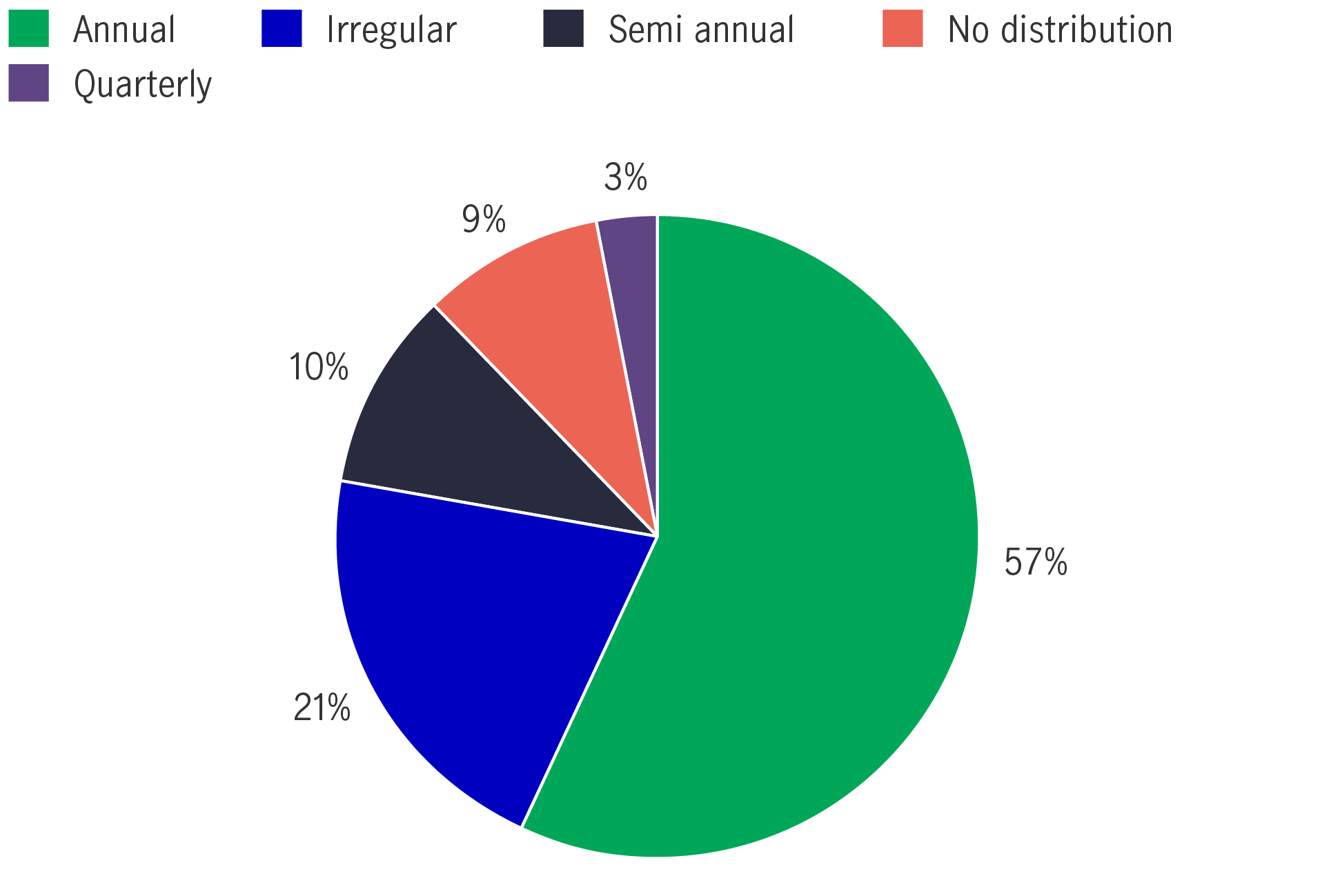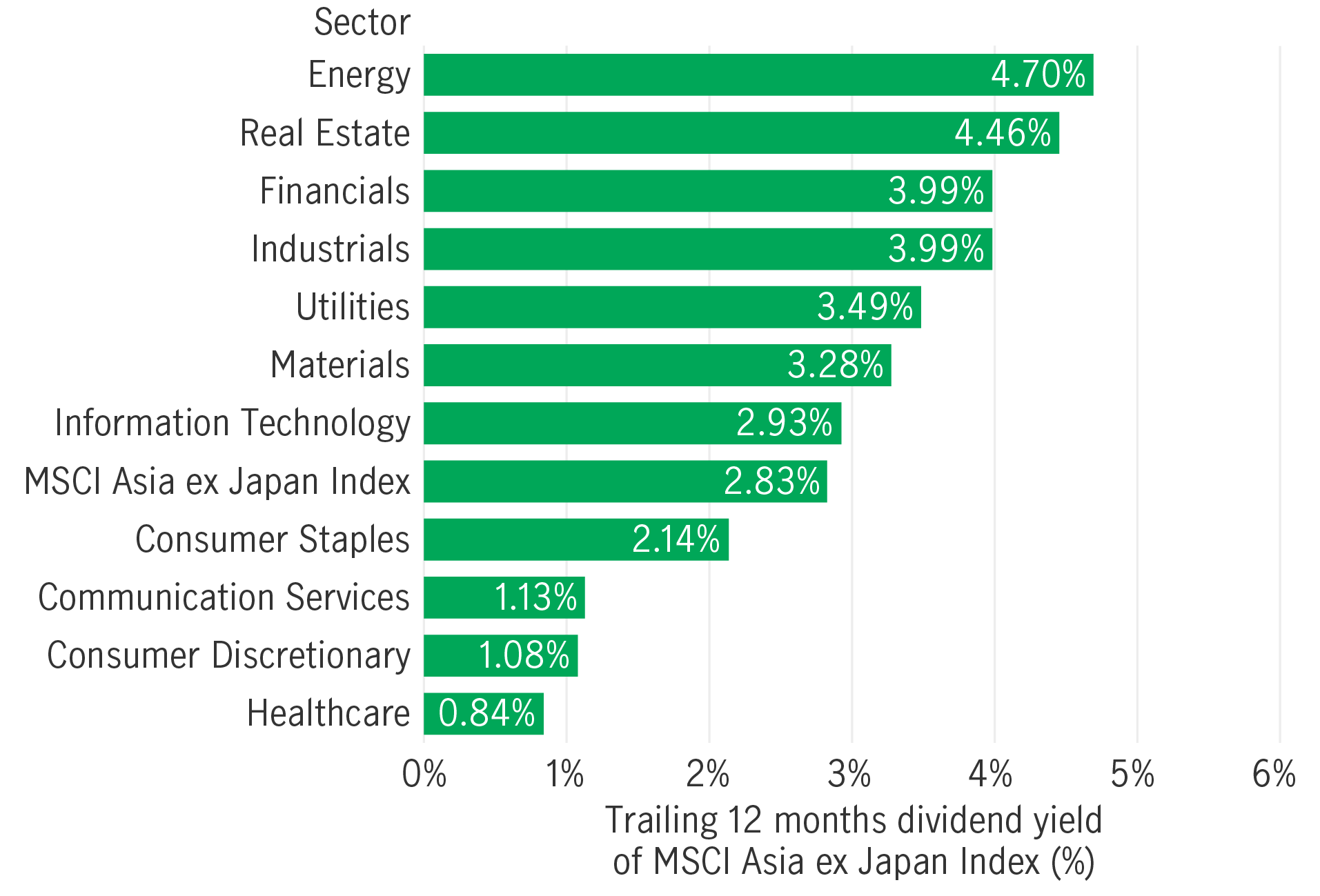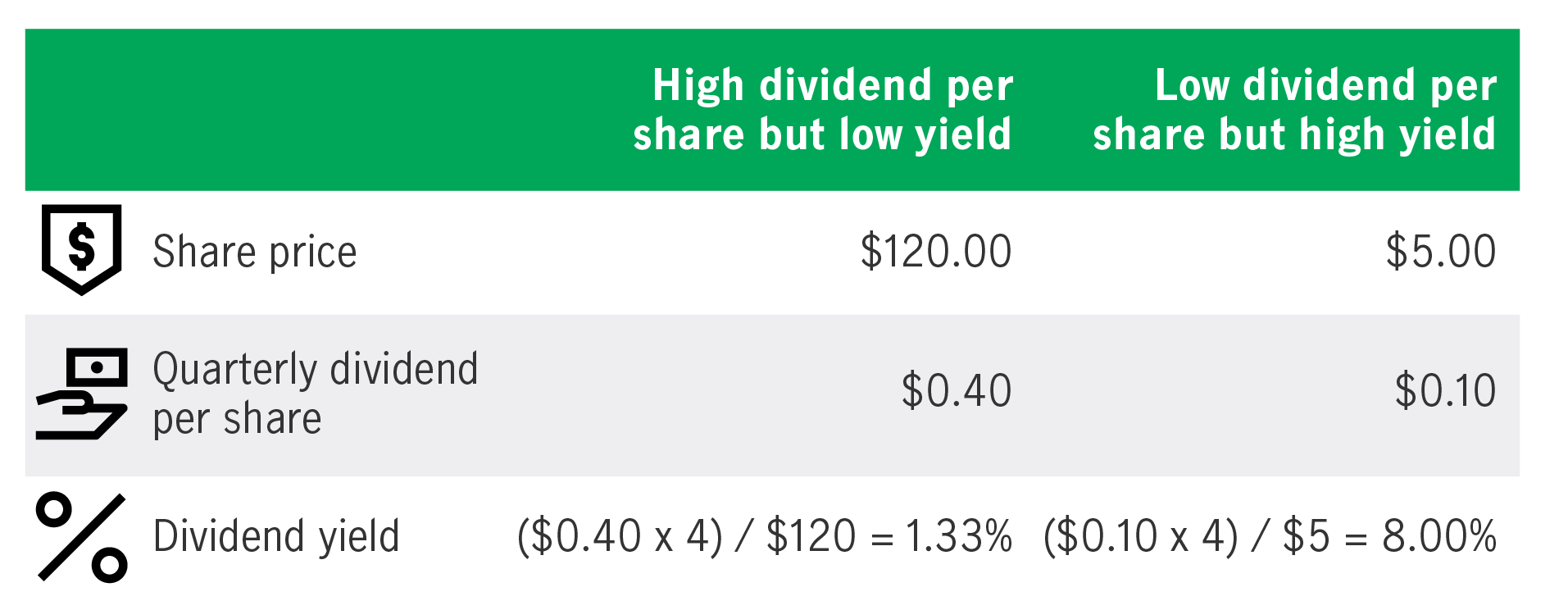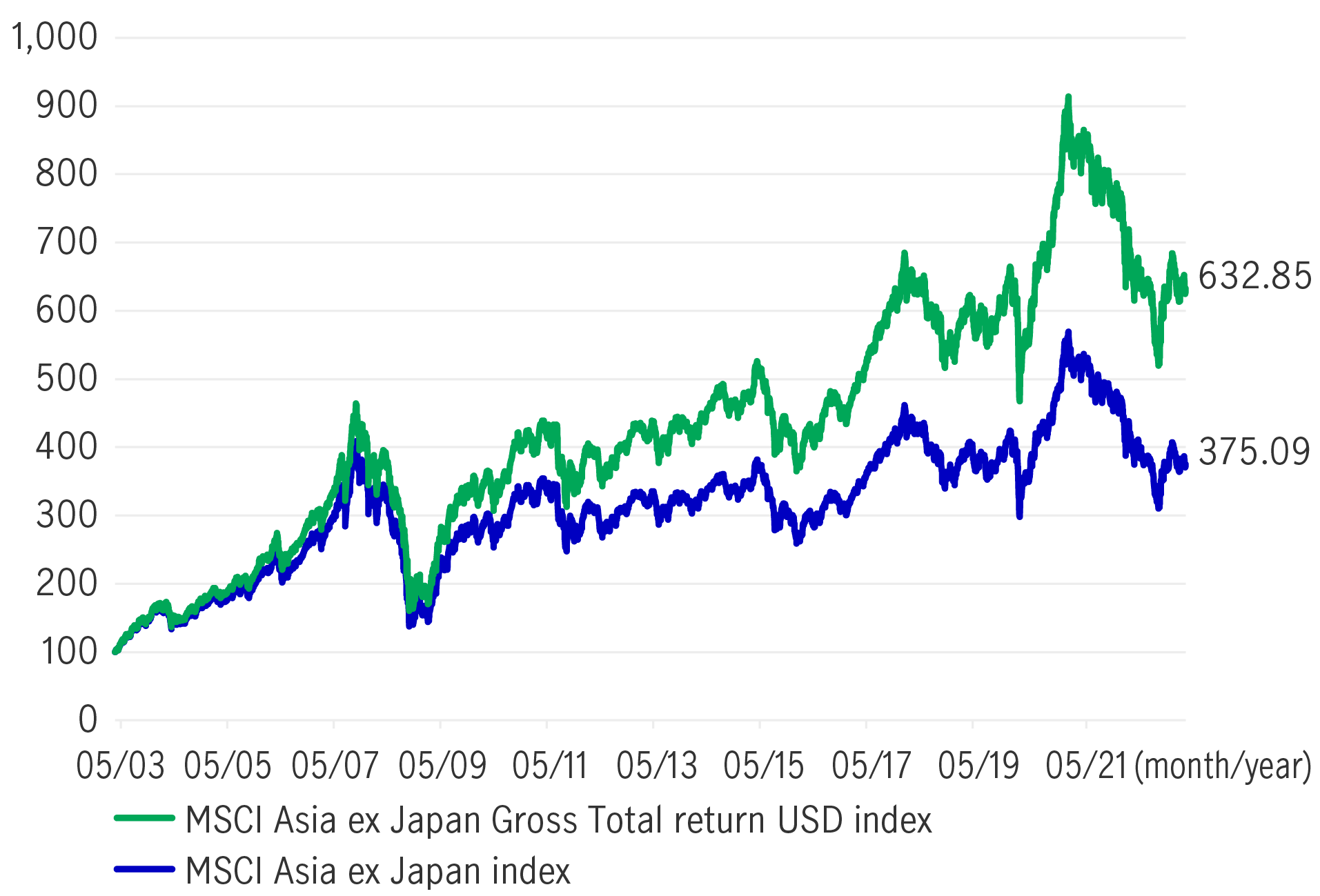
1 June 2023
Dividends can be a significant source of returns for equity investors. What are dividends? Do dividend-paying companies make for a good investment? And how do dividends fit into portfolio construction? We explore and answer those questions.
Dividends are the payments a public company (a company whose shares trade on an exchange) makes to its owners (shareholders). Dividends are a way for companies to return some of their profits to their owners. You may receive dividends directly if you own the shares of a public company or indirectly (in the form of distributions) if you own mutual funds, exchange-traded funds (ETFs), or other pooled vehicles that hold equities.
Each company determines how often it will pay dividends (if at all), which is explained in its dividend policy. Over two-thirds of Asian companies pay dividends regularly1, with many making annual distributions. Only a small proportion of companies are willing to distribute more frequently, such as semi-annually (10%) or quarterly (3%). Notably, over 20% of companies do not have a regular distribution plan. In addition to regularly scheduled dividends, companies may issue special one-off dividend payments, subject to specific events, such as recording a large profit after selling assets or commemorating a company anniversary.
The Board of Directors of each company determines the company’s dividend policy.
Dividend distribution frequency among Asian companies1

Since it’s not a requirement, not all public companies pay dividends. Generally, companies will look at their financial conditions, such as profitability, balance sheet health, and future funding needs, before deciding whether they will pay a dividend and how much they will distribute. Companies are likely to pay a higher dividend as their businesses steadily grow, become more profitable and/or face less demand for capital expenditure, but that’s not a concrete rule. There are large, profitable companies that don’t pay dividends.
Dividend policies also tend to be very different between sectors. In Asia, companies in the energy and real estate sectors currently have the highest dividend yield at 4.70% and 4.46%, respectively, while healthcare (0.84%) and consumer discretionary (1.08%) have the lowest.2
Dividends vary significantly between sectors

Each company’s dividend policy is public information and can usually be found on its website, within its regulatory filings, or on any major financial publication’s website. Although you can easily find out how much a company (or a mutual fund) pays per share, it’s also helpful to calculate its dividend yield (its dividend payments as a percentage of its stock price). The dividend yield tells you how much income you’ll get from the company for every dollar you invest in it (assuming its dividend policy doesn’t change and the payments are made). It’s simply the annual dividend per share divided by the price per share (or the net asset value of a mutual fund).
Dividends per share vs. dividend yield

For illustration purposes only.
There are critical differences between the types of income you might receive from investing in a company. Dividends are only paid to the owners (shareholders) of the company. On the other hand, interest payments are made to a company’s creditors—those who hold the company’s bonds. Also, as mentioned, dividends don’t have to be paid, but bond interest payments (except zero-coupon bonds) are contractual, and if they aren’t paid, the company could be in default.
In some markets, shareholders/bondholders are liable for tax payments relating to their dividend/bond interest incomes. This means not all the distribution income shared by listed companies/bond issuers will go into investors’ pockets. Also, the tax rates of dividends and bond interests may vary.
Dividends have significantly contributed to investors’ total returns (returns from both capital appreciation and dividends) over time. Over time, largely thanks to the power of compounding, dividends can be a major component of a portfolio’s returns. For example, over the last 20 years, the cumulative price return of the MSCI Asia ex-Japan Index is 275% (to end April 2023). This is equivalent to a compound annual growth rate of 6.83%. But taking into account reinvested dividends over the same investment period, the total return would be 533%, with a compound annual growth rate of 9.67%.
Cumulative price returns vs total returns of investing MSCI Asia ex Japan Index

Source: Bloomberg, as of 30 April 2023. Index values are rebased to 100 as of 30 April 2003. Returns are based on the MSCI Asia ex-Japan Index price return and total return in US dollars. It is not possible to invest directly in an index.
Investors can also choose to reinvest dividend payments back into the market to take advantage of the power of compounding. When doing so, the dividends you receive are used to buy additional shares in the company, which could potentially increase the amount you receive at the next dividend payment date, so you’d purchase even more shares, and so on.
Dividends can also be a reliable source of income in market downturns, weaker economies, and times of high inflation. Corporations generally hesitate to lower or cancel their dividend, even in tough economic times. That’s because the market tends to punish companies that do so without a proper explanation and plan to get their dividends back on track – it can take years for a company to earn back investors’ trust as a solid dividend payer. Dividends can also help fight inflation since receiving cash dividends means you don’t necessarily have to sell any stock to generate cash. Moreover, in response to high inflation, some companies can actually increase the price they charge for their goods, which can help generate profits that may be returned to investors in the form of dividends.
With a demonstrated history of adding to total returns, and their potential to provide income in difficult economic environments, dividend-paying companies can be a great addition to one’s portfolio. But not all dividend-paying companies are created equal, and some are more suitable for certain investor types than others, so security selection is paramount. Moreover, a company’s dividend policy is just one of the many elements to consider in evaluating the suitability of a stock for your portfolio. Like any investment, they should be considered as part of a wider portfolio construction strategy and should be part of a diversified portfolio.
1 Source: Bloomberg, as of 25 May 2023. Dividend distribution frequency information is based on the constituents of the following major Asian equities indices: Hong Kong Hang Seng Index, China Shanghai Shenzhen CSI 300 Index, Taiwan Stock Exchange Weighted Index, Korea Stock Exchange KOSPI Index, India S&P BSE SENSEX Index, Singapore Straits Times Index, FTSE Bursa Malaysia KLCI Index, Stock Exchange of Thailand SET Index, Indonesia Jakarta Stock Exchange Composite Index, and Philippines Stock Exchange PSEi Index. Distribution of dividends, the frequency of distribution and the amount/rate of dividends are not guaranteed. Positive distribution yield does not imply positive return. It is not possible to invest directly in an index.
2 Source: Bloomberg, data as of 4 May 2023. The above material is for illustration purposes only. Distribution of dividends, the frequency of distribution and the amount/rate of dividends are not guaranteed. Positive distribution yield does not imply positive return. It is not possible to invest directly in an index.
Manulife Investment Management is the global wealth and asset management segment of Manulife Financial Corporation. The information and/or analysis contained in this material have been compiled or derived from sources believed to be reliable at the time of writing but Manulife Investment Management does not make any representation as to their accuracy, correctness, usefulness or completeness and does not accept liability for any loss arising from the use hereof or the information and/or analysis contained herein. Neither Manulife Investment Management or its affiliates, nor any of their directors, officers or employees shall assume any liability or responsibility for any direct or indirect loss or damage or any other consequence of any person acting or not acting in reliance on the information contained herein.
This material was prepared solely for educational and informational purposes and does not constitute a recommendation, professional advice, an offer, solicitation or an invitation by or on behalf of Manulife Investment Management to any person to buy or sell any security. Nothing in this material constitutes financial, investment, legal, accounting or tax advice, or a representation that any investment or strategy is suitable or appropriate to your individual circumstances, or otherwise constitutes a personal recommendation to you. Past performance is not an indication of future results. Investment involves risk. In considering any investment, if you are in doubt on the action to be taken, you should consult professional advisers.
Proprietary Information – Please note that this material must not be wholly or partially reproduced, distributed, circulated, disseminated, published or disclosed, in any form and for any purpose, to any third party without prior approval from Manulife Investment Management.
These materials have not been reviewed by, are not registered with any securities or other regulatory authority, and may, where appropriate, be distributed by the following Manulife entities in their respective jurisdictions.
Malaysia: Manulife Investment Management (M) Berhad 200801033087 (834424-U). Singapore: Manulife Investment Management (Singapore) Pte. Ltd. (Company Registration Number: 200709952G). Philippines: Manulife Asset Management and Trust Corporation. Australia, South Korea and Hong Kong: Manulife Investment Management (Hong Kong) Limited in Hong Kong and has not been reviewed by the HK Securities and Futures Commission (SFC).
Risk Diversification
There is no free lunch. But Risk Diversification comes close in investing. A diversified portfolio was shown to optimize returns with lower volatility in the long run.
On Inflation, Diversification, and Excessive Cash
Amid volatile market conditions and higher interest rates, seeking security by burying your savings in a deposit account is tempting. As the saying goes, “cash is king”. Or is it?
Better Income Approach to Income Investing
A “Better Income” approach seeks to understand an investor’s investment objective alongside the underlying risk of certain levels of income generation. “Better” income may not refer to the highest income level but the stability and consistency of reasonably higher yields generated throughout various market cycles.